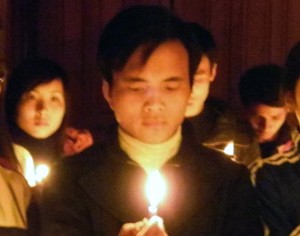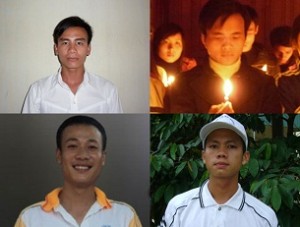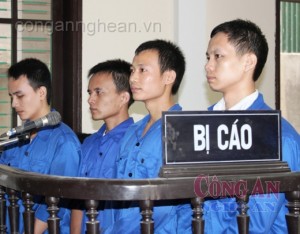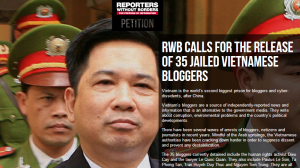More information about Vietnam is available on the Vietnam Page and from other Department of State publications and other sources listed at the end of this fact sheet.
U.S.-VIETNAM RELATIONS
The United States established diplomatic relations with Vietnam in 1950, following its limited independence within the French Union; France continued to oversee Vietnam’s defense and foreign policy. In 1954, Vietnamese nationalists fighting for full independence defeated France, and the now-divided Vietnam entered into two decades of civil war. The United States did not recognize North Vietnam’s government, maintaining the U.S. Embassy in South Vietnam, supporting the South against the North, and entering the war on the South’s side. In 1975, the United States closed its Embassy and evacuated all Embassy personnel just prior to South Vietnam’s surrender to North Vietnamese forces.
Vietnam was reunified under communist rule. In 1978, it invaded Cambodia following border clashes. U.S. policy held that normalization of its relations with Vietnam be based on withdrawal of the Vietnamese military from Cambodia as part of a comprehensive political settlement and on continued cooperation on prisoner of war/missing in action (POW/MIA) issues and other humanitarian concerns. In 1995, the United States announced the formal normalization of diplomatic relations with Vietnam.
U.S. relations with Vietnam have become increasingly cooperative and broad-based in the years since political normalization. In July 2013, Presidents Obama and Sang launched the U.S.-Vietnam Comprehensive Partnership, an overarching framework for advancing the bilateral relationship. The new partnership advances key initiatives to bolster U.S.-Vietnam relations and underscores the enduring U.S. commitment to the Asia-Pacific rebalance. The partnership provides a mechanism to facilitate cooperation in areas including political and diplomatic relations, trade and economic ties, science and technology, education and training, environment and health, war legacy issues, defense and security, protection and promotion of human rights, and culture, sports, and tourism. Vietnam is a partner in nonproliferation regimes, including the Global Initiative to Combat Nuclear Terrorism, and takes advantage of expertise, equipment, and training available under the Export Control and Related Border Security program. With the support of the U.S. Department of Energy’s Megaports Initiative, Vietnam is installing radiation detection equipment to help it detect and identify weapons of mass destruction and their components at the commercial port of Cai Mep-Vung Tau. The United States and Vietnam have signed an agreement on counternarcotics. The United States and Vietnam hold a regular dialogue on human rights.
The United States considers achieving the fullest possible accounting of Americans missing and unaccounted for in Indochina to be one of its highest priorities with Vietnam. The Joint POW/MIA Accounting Command conducts four major investigation and recovery periods a year in Vietnam, during which specially trained U.S. military and civilian personnel investigate and excavate hundreds of cases in pursuit of the fullest possible accounting. Vietnamese-led recovery teams have become regular participants in these recovery missions since August 2011.
Vietnam remains heavily contaminated by explosive remnants of war, primarily in the form of unexploded ordnance (UXO) including extensive contamination by cluster munitions dating from the war with the United States. The United States is the largest single donor to UXO/mine action in Vietnam, and the two countries signed a memorandum of understanding on continued unexploded ordnance cooperation in December 2013. While legacy issues such as UXO/demining, MIA accounting, and Agent Orange (a defoliant used by U.S. forces) provided the foundations for the U.S.-Vietnam defense relationship, mutual interest in addressing the challenges of humanitarian assistance/disaster relief, search and rescue, and maritime security have allowed the defense relationship to accelerate, with Vietnam participating in U.S.-provided capacity-building training in these areas. Many of these topics are discussed in annual bilateral defense discussions. In 2011, the U.S. Department of Defense and the Vietnamese Ministry of National Defense signed a landmark Memorandum of Understanding during the Defense Policy Dialogue that will further advance bilateral defense cooperation. In December 2013, Secretary of State John Kerry announced an initial commitment of new regional and bilateral assistance to advance maritime capacity building in Southeast Asia, including up to $18 million in new assistance to Vietnam to enhance the capacity of coastal patrol units to deploy rapidly for search and rescue, disaster response, and other activities. This assistance directly responds to priorities identified in the Joint Minutes on Vietnam and U.S. Coast Guard Maritime Cooperation signed in October 2013 by the Vietnamese and U.S. Coast Guard Commandants.
U.S. Assistance to Vietnam
In the 1980s, Vietnam introduced market reforms, opened up the country for foreign investment, and improved the business climate. It became one of the fastest-growing economies in the world. Vietnam’s rapid economic transformation and global integration has lifted millions out of poverty and has propelled the country to the ranks of lower-middle-income status. U.S. assistance in Vietnam focuses on consolidating gains to ensure sustainable economic development while promoting good governance and the rule of law. Assistance projects aim to deepen regulatory reforms, improve the capacity and independence of Vietnam’s judicial and legislative bodies, and promote more effective public participation in the law and regulation-making processes. U.S. assistance also seeks to support Vietnam’s response to climate change and other environmental challenges, including remediating Agent Orange/dioxin contamination, strengthening the country’s health and education systems, and assisting vulnerable populations.
Bilateral Economic Relations
Since entry into force of the U.S.-Vietnam bilateral trade agreement in 2001, trade between the two countries and U.S. investment in Vietnam have grown dramatically. The United States and Vietnam have concluded a trade and investment framework agreement; they also have signed textile, air transport, and maritime agreements. The two countries, along with other Asia-Pacific nations, are part of the Trans-Pacific Partnership negotiations, with the goal of concluding a a high-standard regional free trade agreement. U.S. exports to Vietnam include agricultural products, machinery, yarn/fabric, and vehicles. U.S. imports from Vietnam include apparel, footwear, furniture and bedding, agricultural products, seafood, and electrical machinery.
Vietnam’s Membership in International Organizations
Vietnam and the United States belong to a number of the same international organizations, including the United Nations, ASEAN Regional Forum, Asia-Pacific Economic Cooperation forum, International Monetary Fund, World Bank, and World Trade Organization.
Bilateral Representation
The U.S. Ambassador to Vietnam is David B. Shear; other principal embassy officials are listed in the Department’sKey Officers List.
Vietnam maintains an embassy in the United States at 1233 20th Street, NW, #400, Washington DC 20036 (tel. 202-861-0737).
More information about Vietnam is available from the Department of State and other sources, some of which are listed here:
Department of State Vietnam Country Page
Department of State Key Officers List
CIA World Factbook Vietnam Page
U.S. Embassy: Vietnam
USAID Vietnam Page
History of U.S. Relations With Vietnam
Human Rights Reports
International Religious Freedom Reports
Trafficking in Persons Reports
Narcotics Control Reports
Investment Climate Statements
Office of the U.S. Trade Representative Countries Page
U.S. Census Bureau Foreign Trade Statistics
Export.gov International Offices Page
Library of Congress Country Studies
Travel and Business Information
Height Insoles: Hi, I do believe this is an excellent site. I stumbledupon …
http://fishinglovers.net: Appreciate you sharing, great post.Thanks Again. Keep writi…
Achilles Pain causes: Every weekend i used to pay a quick visit this site, as i w…






February 15, 2014
U.S. Relations With Vietnam
by Defend the Defenders • [Human Rights]
More information about Vietnam is available on the Vietnam Page and from other Department of State publications and other sources listed at the end of this fact sheet.
U.S.-VIETNAM RELATIONS
The United States established diplomatic relations with Vietnam in 1950, following its limited independence within the French Union; France continued to oversee Vietnam’s defense and foreign policy. In 1954, Vietnamese nationalists fighting for full independence defeated France, and the now-divided Vietnam entered into two decades of civil war. The United States did not recognize North Vietnam’s government, maintaining the U.S. Embassy in South Vietnam, supporting the South against the North, and entering the war on the South’s side. In 1975, the United States closed its Embassy and evacuated all Embassy personnel just prior to South Vietnam’s surrender to North Vietnamese forces.
Vietnam was reunified under communist rule. In 1978, it invaded Cambodia following border clashes. U.S. policy held that normalization of its relations with Vietnam be based on withdrawal of the Vietnamese military from Cambodia as part of a comprehensive political settlement and on continued cooperation on prisoner of war/missing in action (POW/MIA) issues and other humanitarian concerns. In 1995, the United States announced the formal normalization of diplomatic relations with Vietnam.
U.S. relations with Vietnam have become increasingly cooperative and broad-based in the years since political normalization. In July 2013, Presidents Obama and Sang launched the U.S.-Vietnam Comprehensive Partnership, an overarching framework for advancing the bilateral relationship. The new partnership advances key initiatives to bolster U.S.-Vietnam relations and underscores the enduring U.S. commitment to the Asia-Pacific rebalance. The partnership provides a mechanism to facilitate cooperation in areas including political and diplomatic relations, trade and economic ties, science and technology, education and training, environment and health, war legacy issues, defense and security, protection and promotion of human rights, and culture, sports, and tourism. Vietnam is a partner in nonproliferation regimes, including the Global Initiative to Combat Nuclear Terrorism, and takes advantage of expertise, equipment, and training available under the Export Control and Related Border Security program. With the support of the U.S. Department of Energy’s Megaports Initiative, Vietnam is installing radiation detection equipment to help it detect and identify weapons of mass destruction and their components at the commercial port of Cai Mep-Vung Tau. The United States and Vietnam have signed an agreement on counternarcotics. The United States and Vietnam hold a regular dialogue on human rights.
The United States considers achieving the fullest possible accounting of Americans missing and unaccounted for in Indochina to be one of its highest priorities with Vietnam. The Joint POW/MIA Accounting Command conducts four major investigation and recovery periods a year in Vietnam, during which specially trained U.S. military and civilian personnel investigate and excavate hundreds of cases in pursuit of the fullest possible accounting. Vietnamese-led recovery teams have become regular participants in these recovery missions since August 2011.
Vietnam remains heavily contaminated by explosive remnants of war, primarily in the form of unexploded ordnance (UXO) including extensive contamination by cluster munitions dating from the war with the United States. The United States is the largest single donor to UXO/mine action in Vietnam, and the two countries signed a memorandum of understanding on continued unexploded ordnance cooperation in December 2013. While legacy issues such as UXO/demining, MIA accounting, and Agent Orange (a defoliant used by U.S. forces) provided the foundations for the U.S.-Vietnam defense relationship, mutual interest in addressing the challenges of humanitarian assistance/disaster relief, search and rescue, and maritime security have allowed the defense relationship to accelerate, with Vietnam participating in U.S.-provided capacity-building training in these areas. Many of these topics are discussed in annual bilateral defense discussions. In 2011, the U.S. Department of Defense and the Vietnamese Ministry of National Defense signed a landmark Memorandum of Understanding during the Defense Policy Dialogue that will further advance bilateral defense cooperation. In December 2013, Secretary of State John Kerry announced an initial commitment of new regional and bilateral assistance to advance maritime capacity building in Southeast Asia, including up to $18 million in new assistance to Vietnam to enhance the capacity of coastal patrol units to deploy rapidly for search and rescue, disaster response, and other activities. This assistance directly responds to priorities identified in the Joint Minutes on Vietnam and U.S. Coast Guard Maritime Cooperation signed in October 2013 by the Vietnamese and U.S. Coast Guard Commandants.
U.S. Assistance to Vietnam
In the 1980s, Vietnam introduced market reforms, opened up the country for foreign investment, and improved the business climate. It became one of the fastest-growing economies in the world. Vietnam’s rapid economic transformation and global integration has lifted millions out of poverty and has propelled the country to the ranks of lower-middle-income status. U.S. assistance in Vietnam focuses on consolidating gains to ensure sustainable economic development while promoting good governance and the rule of law. Assistance projects aim to deepen regulatory reforms, improve the capacity and independence of Vietnam’s judicial and legislative bodies, and promote more effective public participation in the law and regulation-making processes. U.S. assistance also seeks to support Vietnam’s response to climate change and other environmental challenges, including remediating Agent Orange/dioxin contamination, strengthening the country’s health and education systems, and assisting vulnerable populations.
Bilateral Economic Relations
Since entry into force of the U.S.-Vietnam bilateral trade agreement in 2001, trade between the two countries and U.S. investment in Vietnam have grown dramatically. The United States and Vietnam have concluded a trade and investment framework agreement; they also have signed textile, air transport, and maritime agreements. The two countries, along with other Asia-Pacific nations, are part of the Trans-Pacific Partnership negotiations, with the goal of concluding a a high-standard regional free trade agreement. U.S. exports to Vietnam include agricultural products, machinery, yarn/fabric, and vehicles. U.S. imports from Vietnam include apparel, footwear, furniture and bedding, agricultural products, seafood, and electrical machinery.
Vietnam’s Membership in International Organizations
Vietnam and the United States belong to a number of the same international organizations, including the United Nations, ASEAN Regional Forum, Asia-Pacific Economic Cooperation forum, International Monetary Fund, World Bank, and World Trade Organization.
Bilateral Representation
The U.S. Ambassador to Vietnam is David B. Shear; other principal embassy officials are listed in the Department’sKey Officers List.
Vietnam maintains an embassy in the United States at 1233 20th Street, NW, #400, Washington DC 20036 (tel. 202-861-0737).
More information about Vietnam is available from the Department of State and other sources, some of which are listed here:
Department of State Vietnam Country Page
Department of State Key Officers List
CIA World Factbook Vietnam Page
U.S. Embassy: Vietnam
USAID Vietnam Page
History of U.S. Relations With Vietnam
Human Rights Reports
International Religious Freedom Reports
Trafficking in Persons Reports
Narcotics Control Reports
Investment Climate Statements
Office of the U.S. Trade Representative Countries Page
U.S. Census Bureau Foreign Trade Statistics
Export.gov International Offices Page
Library of Congress Country Studies
Travel and Business Information